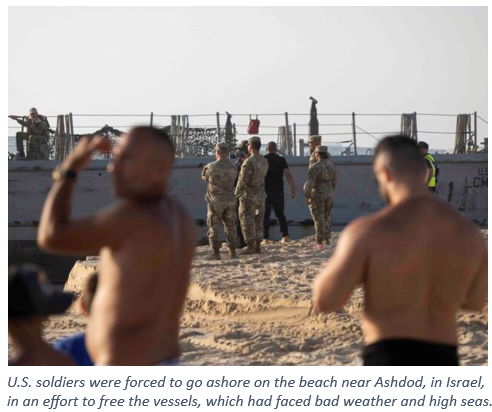FOUR U.S. ARMY SHIPS RUN AGROUND NEAR FLOATING GAZA PIER; ‘BOOTS ON THE GROUND’
 Four of the U.S. Army vessels supporting the “floating pier” in Gaza broke from their moorings Saturday and ran aground, with two of the four beaching themselves on the Israeli coast.
Four of the U.S. Army vessels supporting the “floating pier” in Gaza broke from their moorings Saturday and ran aground, with two of the four beaching themselves on the Israeli coast.
The Navy Times reported:
Four U.S. Army vessels supporting the maritime humanitarian aid mission in Gaza broke free from their moorings due to heavy sea states Saturday, U.S. Central Command said.
Two of the vessels are anchored on the beach near the floating pier off the Gaza coast, while the third and fourth vessels are beached on the Israeli coast near Ashkelon, a coastal city approximately eight miles north of the Gaza Strip.
No injuries have been reported and the U.S.-built pier remains fully functional, CENTCOM said, adding that no U.S. personnel will enter Gaza.
Video circulated online of efforts to free the vessels:
Day 2 of the US army landing craft LCM 8558 on the beach of Ashdod along with a tug that is often referred to as part of the floating pier but is actually a kind of vessel used to help move the pier. The tug broke free when the floating pier was being taken to Ashdod due to heavy… pic.twitter.com/NHwWBUCu16
— Seth Frantzman (@sfrantzman) May 26, 2024
President Joe Biden promised in his State of the Union address that there would be no “boots on the ground” to support the pier.
Joel B. Pollak is Senior Editor-at-Large at Breitbart News and the host of Breitbart News Sunday on Sirius XM Patriot on Sunday evenings.
[Commentary:]
As a former active duty U.S. Marine, I was with the 2nd Fleet Marine Force Atlantic. That’s the Marine Expeditionary Force responsible for amphibious assaults, so we know a few things about what will float and what won’t float.
No matter how much money you throw at something, in this case $330 million dollars, if it won’t float before, it’s not going to float after. So you can’t build a floating pier over a shallow sandy seabed in breaking surf without pile-drivers.
Traditional anchor systems do not hold in sand. The constant wave action dislodges the anchors and they are difficult to reset, no matter how much scope is paid out.
The barge decks that attach to each other creating the 215 yard pier ends in an area that is too shallow for large supply ships to dock. Even if they could dock, there are no secure bollards to tie off the mooring lines of the ship.
Essentially, the relief ship would have four sets of five pilings driven into the sea floor at the end of the dock, and then an evenly spaced set of three pilings along the length of the pier that would hold all of the sections together.
The pier would then be able to rise and fall with the waves and tides on rollers fitted around the pilings.
That type of pier could conceivably last for years.
Without those pilings, without enough deep water for deep-draft vessels, and with no fixed moorings for the ships to tie-up at, there is no chance of success.
I’m not being critical, I’m just stating the facts.
The first fully loaded transports that receive aid to move from the ship’s berth to the beachhead will destroy the whole floating pontoon bridge.
That’s not what the floating pier sections are built for – they’re for one fixed bridge head to connect to another fixed bridge head, not a free-floating heavy-cargo high-traffic humanitarian corridor with no fixed anchorage, no sea wall or jetty, and no pilings.
It just won’t work.
But what will work, what would be highly effective and economically viable, is to break down the air-dropped aid into 5-meal packs with small parachutes that can be dropped in mass over densely populated urban areas – they won’t kill people if the meals land on them.
We have literally millions of small parachutes that are used for various tasks like illumination flares. They’re cheap and readily available.
We could air-drop millions of single family food packages weighing less than five pounds directly over the drop zone and not have to worry about a 400 pound crate falling at 40 mpg killing a large percentage of the refugees scrambling to get the aid.
We need to put our thinking caps back on again.
$330 million would cover the cost of 900 million single family food packs, and they could use the parachutes to make shelters, as well.
Naval ship captains and Merchant Marine masters of the ship are relieved of command for running aground. DEI yields a sad end to proud careers with spotless records.


